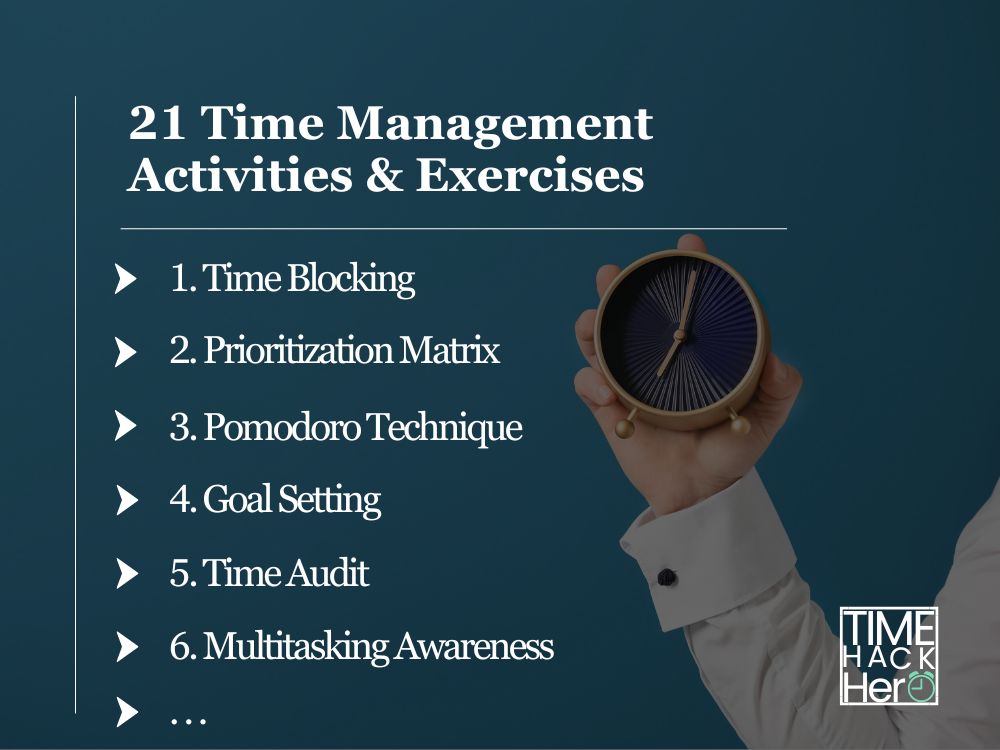In today’s fast-paced world, effective time management is essential for personal and professional success. It’s important to master techniques that help you prioritize tasks, set goals, and maximize productivity. In this article, you’ll learn about 19 time management activities and exercises that will help improve your efficiency and achieve your desired outcomes.
These time management activities and exercises are designed to be engaging, fun, and practical. They can be adapted for individuals or teams, making them suitable for both personal growth and workplace training. By incorporating these activities into your daily routine, you’ll quickly see improvements in your ability to manage your time and accomplish more with greater ease.
Table of Contents
21 Time Management Activities & Exercises
To improve your time management skills, try out the following 21 activities and exercises that can boost productivity and lead to a more efficient use of time:
1. Time Blocking
Time blocking is an effective way to manage your day by allocating specific time slots to each task on your to-do list. By organizing your schedule with time blocks, you can prioritize tasks, maintain focus, deter procrastination, and ultimately increase your productivity.
To start time blocking, first create a list of tasks that you need to complete within a day or a week. Break down the tasks into smaller, manageable parts and estimate the time required to complete each. Next, assign specific time blocks to these tasks in your calendar or planner. Ensure you allocate sufficient time to each task, including buffers for any unexpected interruptions or delays.
Consider the time of day when you are most productive and schedule the most important or complex tasks during those hours. Don’t forget to schedule breaks, as regular breaks can help maintain your focus and prevent burnout. Short breaks for stretching, walks, or simply resting your eyes can make a big difference in your overall productivity.
To effectively implement time blocking, you need to adhere to the designated schedule. Use timers or productivity apps to track your progress and time spent on each task. Additionally, monitor and adjust your time blocks as needed to find the optimal balance for your individual needs.
Lastly, remember to track your progress and reflect on your accomplishments after completing each task. This will not only keep you motivated but also help you make improvements to your time blocking strategy for better time management in the future.
2. Prioritization Matrix
A prioritization matrix helps you manage your tasks more efficiently by classifying them based on their importance and urgency. By using this method, you can focus on tasks that are crucial for achieving your goals and reduce time spent on less significant activities.
To create a prioritization matrix, start by listing all of your tasks on a piece of paper or in a digital tool. Next, sort them into four categories according to their importance and urgency:
- High importance and high urgency: These tasks should be your top priority, as they have a significant impact and need immediate attention.
- High importance and low urgency: These tasks are important but don’t require immediate action. Schedule them soon after completing high-priority tasks.
- Low importance and high urgency: These tasks might not be crucial for your overall success but still demand timely action. Delegate or work on them after addressing high-importance ones.
- Low importance and low urgency: These tasks should be your lowest priority. Complete them when you have spare time or consider delegating or dropping them entirely.
You can enhance your prioritization matrix by incorporating color-coding, which can help you visualize high-priority items more easily. Assign a color for each priority level and apply it to the tasks accordingly. For example, you might use red for high importance and high urgency, yellow for high importance and low urgency, green for low importance and high urgency, and blue for low importance and low urgency.
Remember to review and update your prioritization matrix regularly, as priorities can change over time or as new tasks arise. This way, you can ensure that you’re always focusing on the most impactful activities, leading to better time management and increased productivity.
3. Pomodoro Technique
The Pomodoro Technique is a time management method that can help you improve your focus and productivity. This technique involves breaking your work into 25-minute intervals, called pomodoros, with short breaks in between. Developed by Francesco Cirillo in the late 1980s, this approach has gained popularity for its simplicity and effectiveness.
To start using the Pomodoro Technique, gather a to-do list and a timer. Set your timer for 25 minutes and focus on a single task until the timer goes off. When your session ends, mark off one pomodoro and record what you’ve completed. Then, take a five-minute break to recharge.
After completing four pomodoros, reward yourself with a longer, more restorative break lasting 15-30 minutes. This cycle allows you to maintain a high level of concentration and manage distractions more effectively.
Some benefits of using the Pomodoro Technique include:
- Improved focus and concentration on tasks
- Reduced stress
- More effective distractions management
- Enhanced daily motivation
- Better time-tracking and time-control habits
Remember to plan how many pomodoro intervals you need in a day to complete your tasks. By doing so, you can ensure that your work is accomplished within a predetermined time frame.
Try out the Pomodoro Technique as one of your time management activities and notice the positive changes it can bring to your daily routine. With consistent practice, you’ll be able to accomplish more in less time while staying focused and composed.
4. Goal Setting
Goal setting is an essential time management activity that allows you to focus on your priorities and allocate your time more effectively. When you set realistic and achievable goals, you’ll find it easier to stay organized and productive.
Begin by identifying areas in your life where you would like to improve or achieve something different. Brainstorm specific, measurable, attainable, relevant, and time-bound (SMART) goals for each area. Combining these elements into your goal-setting process will increase your success rate.
To make your goals more tangible, write them down and create a visual representation, such as a vision board or a goal chart. This will help you to stay committed to the goals and track your progress.
Next, break down your long-term goals into smaller, manageable milestones. These stepping stones will make it easier to work towards and achieve your goals in a systematic and organized manner. Set deadlines for each milestone, and prioritize them based on importance and urgency.
Lastly, review and adjust your goals periodically. This helps to ensure they remain realistic, attainable, and relevant to your life. Regular self-reflection and evaluation of your progress will keep you accountable and ensure that you are making effective use of your time to reach your desired outcomes.
Remember, goal setting isn’t a one-time activity. It’s an ongoing process that requires commitment and discipline, but it’s well worth the effort. By setting SMART goals and sticking to them, you’ll find that your time management skills will significantly improve, leading you to greater success and personal growth.
5. Time Audit
A time audit is an invaluable activity to help you identify where your time is spent and how to use it more effectively. To begin, pick a typical week to monitor your daily activities. This will provide a representative sample of your average time usage.
During your chosen week, write down all your daily activities as they happen. For instance, include both work-related tasks such as checking emails and non-work tasks like taking breaks. Be consistent in recording your activities daily; this will provide a comprehensive view of your time allocation.
Once you’ve gathered the data from your week-long time audit, analyze it by categorizing the tasks into various groups, such as work, personal, leisure, and others. This will help you visualize where most of your time is spent and identify any inefficiencies.
After categorizing your activities, assess the time spent on each task and question the necessity of each. Determine which activities are essential, which can be delegated or outsourced, and which ones can be eliminated altogether.
Finally, after careful analysis, reevaluate the way you allocate your time and make necessary changes to enhance productivity. Creating a new daily schedule based on your findings can greatly improve your time management skills and increase overall efficiency. Remember to periodically conduct time audits to ensure you’re consistently making the most of your available time.
6. Multitasking Awareness
Multitasking can be an efficient way to work, but it can also create distractions that hinder effective time management. To improve your multitasking skills and become more aware of how you divide your attention, try the following exercises:
1. Evaluate your current multitasking habits: Observe your daily routine and notice if you jump between tasks, how often you switch, and whether or not it helps you get more done. You may realize that you’re not truly multitasking, but rather shifting focus between activities, which can decrease overall productivity.
2. Make a to-do list: Create a daily plan of action by listing tasks on a notepad. Allocate a specific amount of time for each task, including breaks. This will help you prioritize your tasks and ensure you stay focused on completing them within the allotted time.
3. Set time limits for each task: Assign a specific duration for each task on your to-do list. Use a timer or an app to keep track of the time spent on each activity. This will help you manage your time more effectively and encourage you to complete tasks within the set limits.
4. Limit distractions: While multitasking, it’s important to minimize any external distractions such as phone notifications, email alerts, or background noise. You can use apps like Focus@Will or Noisli to create a productive work environment and increase your concentration.
5. Practice mindful multitasking: Focus on one task entirely for a short period, then switch to another task and give it your full attention. This technique can help you maintain focus and avoid the common pitfalls of multitasking, such as decreased productivity and increased stress.
With practice and patience, you can improve your multitasking awareness and become more efficient in managing your time. Remember to periodically re-evaluate your habits and adjust your strategies to suit your needs and environment.
7. Decluttering and Organization
Decluttering and organization are essential aspects of time management. By creating a well-organized environment, you can focus more on your tasks and reduce the time spent searching for misplaced items. Let’s explore some activities you can do to improve your decluttering and organization skills.
First, set aside time each month to declutter your workspace or home. Assess which items are essential and which ones can be donated, sold, or discarded. It might be helpful to make a list of items you own and categorize them based on their importance or frequency of use. This process helps you keep track of what you have and prevents clutter from accumulating.
Next, designate specific areas for specific items. Having a designated space for each of your belongings makes it easier to locate them when needed. Invest in storage solutions like filing cabinets, shelves, and desk organizers to help create a structured environment.
Furthermore, consider going digital to reduce physical clutter. Scan important documents and store them electronically for easy access and retrieval. Use cloud-based services to synchronize your files across devices and access them from anywhere.
To maintain a consistent organizational system, create routines that help you stay on top of things. Make it a habit to put things back in their designated spaces after using them. Set aside time each day or week to tidy up and maintain order.
Lastly, apply time management techniques to your decluttering sessions. Set a timer for short bursts of focused cleaning and organizing, known as the Pomodoro Technique. This method involves working for 25 minutes, followed by a short break, and then repeating the process. This technique proves effective in keeping you focused and productive during decluttering sessions.
By practicing these decluttering and organization activities, you’ll create an efficient workspace that saves you time and reduces stress.
8. Deadlines and Reminders
Setting deadlines and reminders can greatly improve your time management skills. By setting deadlines, you impose a sense of urgency and accountability for your tasks, leading to a more focused and efficient approach to work.
To begin, always set realistic deadlines for your projects and tasks. Avoid setting overly ambitious targets which may lead to stress and potential burnout. Break down larger tasks into smaller, manageable milestones, and set deadlines for each of them. This way, you can track your progress and make adjustments as needed.
Creating reminders is another essential aspect of time management. Utilize digital tools like calendar applications, task management software, or even simple alarm clocks to keep track of your deadlines. Schedule your reminders to notify you in advance of a deadline, giving you ample time to wrap up any pending work.
Consider the following tips for successful deadlines and reminders:
- Prioritize tasks based on their importance and urgency. Focus on high-priority tasks first and set earlier deadlines for them.
- Be flexible with your deadlines when necessary. It is okay to adjust them if unforeseen circumstances arise or if you have underestimated the time needed for a task.
- Schedule reminders at strategic intervals, allowing you sufficient time to make progress before being prompted again. For example, set reminders at the start, middle, and end of a project.
- Use visual aids, such as color-coded sticky notes or categorizing tasks in your task management software. This can help ensure that urgent deadlines stand out and are not overlooked.
Remember, setting deadlines and reminders is all about finding a balance between pushing yourself to achieve your goals and maintaining a sustainable and healthy work pace. By consistently applying these strategies, you can optimize your time management skills and increase your productivity.
9. Reflect and Learn
Time management is a skill that can be developed with practice and reflection. In this activity, take time each day to reflect on how effectively you have managed your time and identify areas for improvement.
Begin by setting aside a quiet space and a specific time each day to reflect on your time management activities. This can be done at the end of the day or during a scheduled break. Make sure to eliminate any distractions, so you can focus on your thoughts and insights.
During the reflection, consider the following aspects of your day:
- Tasks completed: List down the tasks you accomplished during the day. This will give you a sense of achievement and show where you have utilized your time effectively.
- Prioritization: Assess whether you have allocated your time to the most important tasks. Think about the decisions you made in prioritizing tasks and if you need to adjust your approach.
- Time-wasters: Identify any activities or habits that wasted your time or hindered your productivity. Determine how you can eliminate or minimize these time-wasters in the future.
- Unexpected events: Reflect on how you managed unexpected events or interruptions, and how you can handle them better in the future.
- Breaks and self-care: Evaluate if you have taken enough breaks and practiced self-care during the day. Taking care of your physical and mental well-being is crucial for effective time management.
Take notes of your reflections, as this will help you track your progress and recognize patterns in your time management habits. Additionally, you can discuss your observations with a mentor, coach, or a peer who is also working on improving their time management skills.
Incorporate the lessons learned from your reflection into your daily time management routine. By doing this regularly, you will notice improvements in your overall productivity and how effectively you manage your time.
10. Time-Boxed Work Sessions
Time-boxing is a time management technique that can help you stay focused and improve your productivity. In a time-boxed work session, you allocate a fixed, maximum unit of time for an activity in advance, and then complete the activity within that time frame. This approach encourages you to concentrate on managing your time rather than just focusing on completing tasks.
To get started with time-boxed work sessions, begin by identifying the tasks you need to accomplish and estimating the amount of time each task should take. Be realistic with your estimations, but also challenge yourself to stay within the time limits you set. Make sure to factor in breaks and any potential disruptions that could occur throughout your day.
Next, schedule your time-boxed work sessions in your calendar, making sure to allot the proper amount of time for each task. This will allow you to visualize your day better and help you stay committed to the time limits you’ve set. It’s also a good idea to share your calendar with your team members, so they know when you’re unavailable.
During your time-boxed sessions, aim to stay focused on the task at hand without getting distracted by other activities or interruptions. If you find yourself struggling to focus or finish within the allocated time, don’t hesitate to adjust your time estimates for future sessions. Remember that the goal is to strike a balance between efficiency and effectiveness.
Here are a few tips to help you succeed with time-boxed work sessions:
- Use a timer or stopwatch to track the time spent on each task.
- Break larger tasks into smaller, manageable chunks.
- Prioritize your tasks based on importance and deadline.
- Regularly evaluate your performance and adjust your time-boxing strategy as needed.
- Consider using focus techniques, like the Pomodoro Technique, to support your time-boxed work sessions.
Incorporating time-boxed work sessions into your routine can help you manage your time more effectively, boost your productivity, and achieve a greater sense of control over your workload. Give it a try and see the positive impact it can have on your workday.
11. Morning Ritual
Establishing a morning ritual can significantly improve your time management, productivity, and overall well-being. As you create a consistent morning routine, you set the tone for your day and ensure better control over your schedule.
Start by waking up early to give yourself ample time to complete your morning tasks. Make sure you get a good night’s sleep, as recommended by Asana’s 21 steps for a more productive day. Ideally, you should aim for at least seven to eight hours of sleep each night.
Develop a morning exercise routine to kickstart your day with energy. Even a simple 15-minute workout or stretching session can have a significant impact on your mood and focus throughout the day. Incorporate healthy habits such as journaling, meditation, or yoga, as mentioned by Verywell Fit. These activities can help alleviate stress, provide mental clarity, and allow you to live with intentionality and purpose.
Prioritize your tasks by creating a daily to-do list before your day starts. Make sure to include both work-related and personal tasks, set realistic deadlines, and use tools like calendars or project management apps to stay organized.
Remember, consistency is key when developing your morning ritual. Stick to your routine for at least a few weeks to fully reap the benefits and establish good time management habits. Adjust your rituals as needed to fit your personal and professional needs, but always prioritize self-care and mindfulness to foster productivity and balance.
12. Power Hour
The Power Hour is a time management activity designed to help you focus and accomplish tasks with high efficiency. During a Power Hour, you will dedicate 60 minutes of uninterrupted time to completing a specific task or set of tasks. This technique can help you overcome distractions, manage your time more effectively, and make significant progress in your work.
To implement the Power Hour, first, identify a task or group of tasks that you need to complete. It’s essential to choose tasks that are important and require your full attention. Next, set a timer for 60 minutes, eliminate potential distractions such as your phone, email notifications, or noisy environments, and begin working on the task.
During the Power Hour, maintain your focus and work diligently on the chosen task. You may want to track your progress by noting how much of the task is completed within the allotted time. It can be helpful to take short breaks if necessary, but keep them to a minimum to sustain your concentration.
Some tips for ensuring a successful Power Hour include:
- Schedule it during your most productive hours of the day.
- Break larger tasks into smaller, manageable sub-tasks.
- Set realistic goals and expectations for what can be accomplished within the hour.
- Use a timer or an app to track your progress and keep you accountable.
Remember, the Power Hour is a versatile technique that can be tailored to suit your unique work style and preferences. The key is to set aside a dedicated block of time and commit to using that time exclusively for the task at hand. By doing so, you can increase your productivity and achieve your goals more efficiently.
13. Batch Processing
Batch processing, also known as time batching, is a time management technique that helps you stay focused and organized by grouping similar tasks together. This strategy allows you to minimize distractions, increase concentration, and boost productivity.
To get started, identify tasks that share a common theme or require similar mental effort. For example, you could batch all your email tasks, like responding to emails, into a designated time block. Or, group together activities like writing reports or making phone calls.
Once you’ve identified your tasks, designate specific time blocks for each batch. During these time blocks, focus solely on the tasks within that batch to maintain your concentration and minimize distractions. You may wish to set a timer to help you stay on track, as this will reinforce your commitment to the task at hand.
Treat each time block like a meeting or appointment. Schedule them into your calendar and stick to them as closely as possible. It’s essential to respect these time blocks and not allow other tasks to interfere. This will help you develop a habit of using batch processing effectively.
Keep in mind that it’s important to be flexible with your time batching. Life is unpredictable, and you may need to adjust your batches to accommodate unforeseen events. Review and adjust your batches regularly to make sure they still align with your workload and priorities.
In summary, batch processing is a helpful technique for managing your time by grouping similar tasks and allocating focused time blocks for each. Stay committed to these time blocks, adapt as necessary, and watch your productivity soar.
14. Delegate and Outsource
Delegating and outsourcing tasks are essential skills for effective time management. When you learn to delegate, you’re freeing up precious time to focus on strategic, high-priority tasks that deserve your attention.
First, identify the tasks that you can delegate to others in your team. These can be routine, time-consuming tasks that don’t require your expertise. You should also consider outsourcing or hiring freelancers for specialized tasks that are outside your area of expertise or don’t align with your core competencies.
To effectively delegate, follow these steps:
- Choose the right person: Match the task with the person’s skills and experience. Ensure they have the proper resources available to complete the task and know where to find them.
- Communicate expectations clearly: Explain the desired outcome, deadline, and any specific protocols or steps the person should follow.
- Monitor progress: Check in on the delegated tasks periodically, without micromanaging. Offer guidance and support when required.
- Provide feedback: Once the task is completed, discuss the results with the person who did the work. Give praise for a job well done and offer constructive feedback on areas that need improvement.
- Trust your team: Resist the urge to take back tasks or redo them yourself. Trust that your team members can handle the tasks you’ve delegated, and give them the space to grow and learn from their experiences.
Outsourcing can be a cost-saving and time-saving measure for non-core tasks, such as graphic design, content creation, or IT support. To successfully outsource, follow a similar process:
- Research potential service providers: Find a reliable and reputable provider with a proven track record in delivering the service you need.
- Clearly define the project: Communicate your expectations, scope, deadlines, and budget upfront to avoid miscommunication or discrepancies later.
- Maintain open communication: Treat the outsourced provider like a member of your team. Keep them in the loop on relevant information and offer support or feedback when necessary.
Remember, by effectively delegating and outsourcing tasks, you can focus on what matters most, ultimately improving your time management and enhancing your overall efficiency and productivity.
15. Mind Mapping
Mind mapping is a powerful time management activity that allows you to visualize your thoughts and ideas. With this technique, you’ll be able to identify connections between ideas, prioritize tasks, and organize your thoughts more effectively.
To create a mind map, start by writing down your main goal or idea in the center of a blank sheet of paper. This will be your starting point. From there, draw branches out from the central idea to represent related thoughts, tasks, or subgoals. Use different colors, symbols, or images to make your mind map more engaging and memorable.
By creating a mind map, you can:
- Organize your thoughts by visually grouping similar ideas together
- Identify connections between seemingly unrelated concepts
- Highlight priorities by focusing on what’s truly important
- Break down complex tasks into smaller, manageable subtasks
As you work with your mind map, you may find it helpful to use the following tips to make it even more effective:
- Use bold text for urgent or high-priority tasks
- Add bullet points to list multiple subtasks under a single branch
- Incorporate tables to compare and contrast different ideas
- Keep your branches visually balanced to
Remember
In summary, mind mapping can be a valuable time management activity that enables you to organize, prioritize, and visualize your tasks and ideas. Give it a try and see how it can improve your productivity and overall time management abilities.
16. Digital Detox
In today’s fast-paced world, it’s essential to have a digital detox to manage your time effectively and focus on what matters most. By cutting down on screen time and increasing offline activities, you can minimize distractions and improve your mental well-being.
Begin by scheduling time away from screens throughout the day. Whether it’s during lunch or after work, allocate periods to engage in activities that don’t involve any devices, such as reading a book, exercising, or spending quality time with friends and family.
Mute notifications on your phone to avoid feeling compelled to check it every few minutes. Identifying and prioritizing the apps that are truly important will help you decrease distractions and dedicate more attention to the task at hand.
Spending more time in nature is another effective way to detox digitally. Taking walks in a park, hiking, or simply sitting in a natural environment can help you disconnect from technology and reconnect with your surroundings.
Cultivate the habit of consuming information mindfully. Instead of aimlessly scrolling through social media feeds, be selective about the content you consume and allocate a specific amount of time to it. This helps prevent feelings of overwhelm and allows you to manage your time well.
Lastly, resist the urge to go online when you wake up. Consider starting your day with a morning routine that doesn’t involve screens, such as meditation or journaling. This sets a positive tone for the rest of your day and allows you to be more focused.
Implementing these digital detox strategies will significantly impact your time management skills and overall well-being. So, take the initiative to unplug and recharge, improving your focus and productivity in the long run.
17. Readjust Priorities
In order to manage your time effectively, it’s essential that you periodically readjust your priorities. As life changes and new situations arise, the importance of different tasks may shift. In order to keep up with these changes and maintain productivity, you should take time to evaluate and readjust priorities as needed.
To do this, first, make a list of all your current tasks and responsibilities. This can include normal daily activities, work assignments, household chores, and more. Be sure to write down everything, no matter how small or insignificant it may seem.
Next, evaluate each task on your list and determine its level of importance based on factors such as deadlines, potential benefits, and personal values. You can use a simple ranking system, such as labeling each task as high, medium, or low priority. Alternatively, you can assign numerical rankings in order to get a more precise view of where each task falls within your list of priorities.
Once you have ranked each task, take a closer look at the tasks in the high-priority group. Are there any tasks that can be delegated or outsourced? If so, consider making arrangements to do so in order to free up more of your time for other high-priority tasks. Additionally, identify any tasks that may no longer be necessary or relevant, and remove them from your list.
After these adjustments, reassess the remaining tasks on your list and ensure that high-priority tasks are properly spaced out and scheduled. Be sure to allocate sufficient time and resources to completing each high-priority task, taking into account factors such as energy levels and focus.
Remember, readjusting your priorities is an ongoing process. Make a habit of regularly evaluating and updating your task list to maintain the most effective and efficient time management strategies possible. By continually readjusting your priorities, you can prevent overwhelm, avoid procrastination, and ultimately achieve a greater sense of balance and accomplishment in your daily life.
18. Time Management Apps and Tools
Time management apps and tools can enhance your productivity and help you stay organized. By using these resources, you can create more structure in your day-to-day life and efficiently manage your tasks.
Best Time Management Apps of 2023:
- Todoist: This app is considered the best overall time management tool. It allows you to create and organize tasks, set deadlines, and track your progress.
- Toggl Track: Perfect for keeping track of your work schedule, Toggl Track makes it easy to monitor the time spent on various tasks and activities.
- TimeTree: Focusing on your personal life, TimeTree is a shared calendar app that helps you manage events, appointments, and to-dos with your family and friends.
- Trello: Ideal for multiple people, Trello is a collaboration tool that allows you to manage projects and tasks effectively with teammates.
- Calendar: Offering additional resources for time management, Calendar is an app that can reduce no-show appointments and improve your overall scheduling process.
- Remember the Milk: Available on multiple platforms, this app assists you in organizing your tasks and setting reminders, so you never forget your responsibilities.
Other Time Management Tools:
- Clockify: A work hours tracker that offers insights into how you spend your time and helps you to improve your productivity.
- Habitica: This RPG game-style task manager is designed to gamify your to-do list and make completing tasks more engaging.
- Plaky: A project and task management software that helps you monitor your progress and delegate tasks to team members.
- ProofHub: A work management and team collaboration platform that makes it easier to keep track of projects, deadlines, and communication within your team.
- Pumble: A communication platform that streamlines team communication and improves collaboration on tasks and projects.
- Asana: An effective team organizer that allows you to create and assign tasks, monitor their progress, and collaborate with your team seamlessly.
- Flow: A project and team manager that makes it easy to organize and prioritize tasks across multiple projects, ensuring that your team is always on the same page.
Incorporating these time management apps and tools into your routine can help you to structure your day, manage tasks effectively, and improve your overall productivity. Try out a few of these options to find the best fit for your personal and professional needs.
19. Energizing Breaks
Energizing breaks can be a vital component in your time management toolkit. They not only help you recharge and refocus, but also make your day more enjoyable and productive. In this section, you’ll discover a variety of energizing break methods to incorporate into your routine.
First, consider short meditation and breathing exercises. Just 10 minutes of relaxation can significantly enhance your focus and clarity. By providing a mental reset, these exercises enable you to tackle tasks with renewed energy and concentration. Don’t worry if you’re new to meditation; simply find a quiet spot, set a timer, and focus on your breath to get started.
Another option is to engage in a quick physical activity, which has been shown to boost energy levels and mental engagement. Some ideas include:
- A brisk walk around your home or office
- Stretching exercises
- Jumping jacks, push-ups, or other bodyweight exercises
If you’re working with a team, consider group activities that energize and promote time management. Scavenger hunts and group counting exercises can be fun, quick, and effective in building team cohesion while giving everyone a mental break.
Remember that energizing breaks are not meant to distract or procrastinate; rather, they should be used strategically to enhance your productivity. Use energizing breaks when you feel your focus or motivation waning, or after you’ve completed a demanding task. This will help ensure that the time spent on breaks leads to higher productivity and better overall time management.
20. Time Management Workshops or Courses
Attending time management workshops or courses can prove beneficial for enhancing your time management skills. These programs offer practical techniques and solutions, which can help you make better use of your time at work and in your personal life.
As you explore and enroll in time management workshops or courses, make sure to choose a program that is tailored to your needs and goals. Consider factors such as the content, duration, and the credibility of the trainers when selecting the most appropriate course. Online courses, face-to-face workshops, and blended programs are available, making it easier for you to find one that suits your preferences and schedule.
During the workshops or courses, you will likely learn the following:
- Prioritization techniques that help you focus on tasks with the highest impact
- Goal-setting strategies that create a clear path towards achieving your objectives
- Time management tools and apps that simplify scheduling, task management, and delegation
- The art of delegating effectively to balance your workload and maintain your focus
- Ways to handle distractions and interruptions that often disrupt your workflow
Furthermore, these workshops or courses provide opportunities to network with other professionals who share similar challenges in managing time effectively. By working together, you can exchange ideas and best practices, fostering personal growth and continuous learning.
To maximize the benefits, it’s essential to apply what you’ve learned from time management workshops or courses to your daily routines. Make it a point to practice these techniques consistently, evaluate your progress, and adjust your approach as needed. Through dedication and persistence, you’ll soon see significant improvements in your time management abilities.
21. Gratitude Practice
Integrating gratitude practices into your daily routine can be an effective way to improve your time management skills. By focusing on the positive aspects of your life, you can feel more motivated and energized, leading to increased productivity and better time management.
Gratitude Journaling: One way to practice gratitude is by maintaining a gratitude journal. Each day, write down five things you’re grateful for, such as accomplishments, people, or experiences. This can be done at bedtime, allowing you to reflect on the day and identify what you appreciated most.
Gratitude Moments: Another approach is to take a few minutes throughout the day to pause and acknowledge moments of gratitude. This can help you foster a mindset of appreciation and reduce stress, contributing to better time management.
Gratitude Exercises: Engage in gratitude exercises, such as meditating on the things you’re grateful for or verbalizing your appreciation to others. This can create positive interactions and facilitate a supportive work environment, further benefiting your time management abilities.
Gratitude Hot Seat: If you’re part of a team, consider implementing a gratitude hot seat activity, where each member takes turns sitting in the hot seat while others share the reasons they appreciate them. This team-building exercise can boost morale, creativity, and productivity, ultimately improving time management.
Remember that consistency is key to obtaining the full benefits of gratitude practices. By incorporating these activities regularly, you can enhance your awareness of the positive aspects in your life and improve your time management skills.
Conclusion
By engaging in time management activities and exercises, you can significantly improve your productivity and overall well-being. These 19 activities are designed to help you develop better time management skills and foster a healthy work-life balance. By incorporating such activities into your routine, you can gain better control over your time and priorities.
While participating in time management games and exercises, remember to remain open to learning and adapting new strategies. It may take some time to see results, but with patience and persistence, you will notice improvements in your daily efficiency and time management abilities.
Don’t be afraid to experiment with different techniques to find the most suitable ones for your individual needs and preferences. As you progress through these various activities, you will naturally discover which strategies work best for your unique circumstances.
Lastly, make it a habit to reflect on your progress regularly. This will help you identify areas for improvement and adjust your time management strategies as needed. By consistently practicing these activities and exercises, you can create a more fulfilling and productive life.









